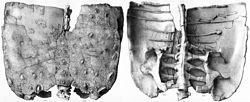| Polacanthus Temporal range: Early Cretaceous,
| |
|---|---|

| |
| Hip armour of Polacanthus foxii | |
| Scientific classification | |
| Domain: | Eukaryota |
| Kingdom: | Animalia |
| Phylum: | Chordata |
| Clade: | Dinosauria |
| Clade: | †Ornithischia |
| Clade: | †Thyreophora |
| Clade: | †Ankylosauria |
| Family: | †Nodosauridae |
| Subfamily: | †Polacanthinae |
| Genus: | †Polacanthus Owen vide Anonymous, 1865 [1] |
| Type species | |
| †Polacanthus foxii Owen vide Anonymous, 1865[2]
| |
| Synonyms | |
| |
Polacanthus, deriving its name from the Ancient Greek polys-/πολύς- "many" and akantha/ἄκανθα "thorn" or "prickle",[5] is an early armoured, spiked, plant-eating ankylosaurian dinosaur from the early Cretaceous period of England.
In the genus Polacanthus several species have been named but only the type species Polacanthus foxii is today seen as valid.
Polacanthus was a quadrupedal ornithischian or "bird-hipped" dinosaur. It lived 130 to 125 million years ago in what is now western Europe.[6] Polacanthus foxii was named after a find on the Isle of Wight in 1865. There are not many fossil remains of this creature, and some important anatomical features, such as its skull, are poorly known. Early depictions often gave it a very generic head as it was only known from the rear half of the creature. It grew to about 5 metres (16 ft) long. Its body was covered with armour plates and spikes. It possibly was a basal member of the Nodosauridae.
- ^ Genus authority given as Huxley, 1867 in some sources, such as the second edition of The Dinosauria.
- ^ Hulke, J.W., 1881. "Polacanthus foxii, a large undescribed dinosaur from the Wealden formation in the Isle of Wight". Philosophical Transactions of the Royal Society of London 172: 653 - 662 https://doi.org/10.1098/rstl.1881.0015
- ^ Delair, J.B., (1982), "Notes on an armoured dinosaur from Barnes High, Isle of Wight", Proceedings of the Isle of Wight Natural History and Archaeological Society for 1980, 7(5): 297-302
- ^ Cite error: The named reference
Blows1987was invoked but never defined (see the help page). - ^ Liddell & Scott (1980). Greek-English Lexicon, Abridged Edition. Oxford University Press, Oxford, UK. ISBN 0-19-910207-4.
- ^ Holtz, Thomas R. Jr. (2012) Dinosaurs: The Most Complete, Up-to-Date Encyclopedia for Dinosaur Lovers of All Ages,https://www.geol.umd.edu/~tholtz/dinoappendix/appendix.html